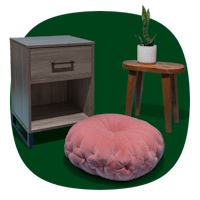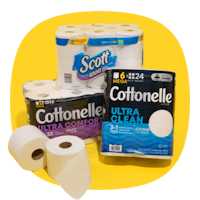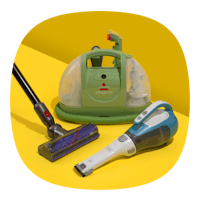
Is it time to replace your pillow?
- Visually examine your pillow: Remove the pillowcase from your pillow and then lay your pillow down on a flat surface. Does it have any lumps or bumps? Does it have a noticeable dent where you rest your head? If you answered yes to either of these questions, it’s time to replace your pillow.
- How do you feel in the morning? Take note of how your head and neck feel in the morning. If you wake up day after day with a crick in your neck, your pillow may not be providing adequate support and you should replace it.
- Perform the “folding test”: Remove the pillowcase from your pillow and then firmly fold your pillow in half, squeezing the air out of it. Let go of the pillow. If it doesn’t spring back to its original shape, then it’s time to replace it.
- Smell your pillow: Remove the pillowcase from your pillow and then give your pillow a good sniff. If your pillow smells like mildew, toss it right away. Continuing to use a mildewy pillow can make you sick, cause respiratory problems and exacerbate your allergies.
- How old is your pillow? Even if your pillow looks good, smells good and passes the “folding test,” if it’s three to five years old, then the experts recommend replacing it. If you have allergies or respiratory problems such as asthma, then you should replace your pillow every one to two years.
How to wash and whiten your pillow
Just because your pillow is yellowed or otherwise discolored or stained, doesn’t mean that it has to be thrown out. On average, you should wash your pillows every six months. To get your pillows looking white and new, follow these instructions:
What you’ll need:
- 1-2 pillows (if you have a top-loading machine, wash 2 pillows at once to keep the machine balanced; if you have a front-loading machine, you can wash 1-2 pillows per load)
- Washing machine
- 1 cup of mild liquid detergent (avoid using harsh or heavily scented detergent; also avoid powdered detergent because it is more likely to leave a residue)
- 1 cup of liquid dishwasher soap
- 1 cup of bleach
- 1/2 cup of borax (you can order borax online or find it at some grocery stores, where it’s sold as “20 Mule Team Borax“)
Instructions:
- Check the care label/washing instructions on your pillow to make sure it’s machine washable. Most pillows made of synthetic materials can be machine-washed.
- Remove the pillowcase and any sort of pillow protector from your pillow(s).
- Start your washing machine using its gentle/delicate, hot water cycle and highest load size setting. Add 1 cup of laundry detergent, 1 cup of liquid dishwasher soap, 1 cup of bleach and 1/2 cup of borax to the hot water.
- Let the water in the machine fill up completely and then agitate for about three minutes so that all the detergent and other ingredients are dissolved before you put your pillow in the machine.
- Place your pillow(s) in the machine and let your washer complete the cycle.
- After your washer has completed its cycle, let it run through the rinse cycle again.
- The drying instructions depend on what type of pillow you have. Always refer to your pillow’s care instructions. Generally, for a foam pillow, line dry or hang it up. For pillows made of other synthetic materials, dry it in your dryer on a low to medium heat setting (avoid high heat). For pillows made of down or other natural materials, avoid heat. Instead, dry your pillow using your dryer’s heat-free “air” setting. For all pillow types, you should stop the dryer every 30 minutes and rotate the pillows to ensure that they dry evenly. It may take more than one dryer cycle to get your pillows completely dry.
Got a limp pillow? Here’s how to re-fluff it
- Dryer sock method: If you’ll be drying your pillow in the dryer (pursuant to the instructions provided above in Step 7), then you can utilize this re-fluffing method. Insert a tennis ball into a sock and then tie the sock into a knot to secure the tennis ball. Toss this tennis ball-in-sock contraption in the dryer along with your pillow to agitate and return the pillow’s fibers back to their natural, fluffy state.
- Sunshine method: Let’s face it: no matter how prim and proper you may be, we all sweat and drool on our pillow during the night. As a result, moisture winds up in our pillow. If you notice that your pillow has lost its fluff, place it outside in the sun on a bright, sunny day for a few hours. Over the course of the day, the sun will help evaporate the moisture from the pillow, causing it to fluff back up.
What this means for your wallet
- I called several dry cleaners (both national and local shops) and asked how much they charge to dry clean a pillow. Depending on the type of pillow and its size (standard, king or European sham), prices ranged from $7.49 to $22.50 per pillow. Washing your own pillow should only cost you about a buck (cost of one washer/dryer load of cleaning materials + plus electricity usage). As you can see, you can save anywhere from $6.49 to $21.50 per pillow by cleaning it yourself at home.
- When most people see a yellow and stained pillow, their first reaction is to throw it out and buy a new one. By cleaning your pillows at home, you won’t have to buy a new one, which will save you the cost of a new pillow (anywhere from $5 to $100 depending on the type of pillow you buy).
- Finally, regularly cleaning and re-fluffing your pillows at home will keep allergies, respiratory problems and back and neck aches at bay, which will ultimately save you money on medical bills and will make you feel better, which is priceless!
For more money-saving tips, check out:
































Tell us what you think